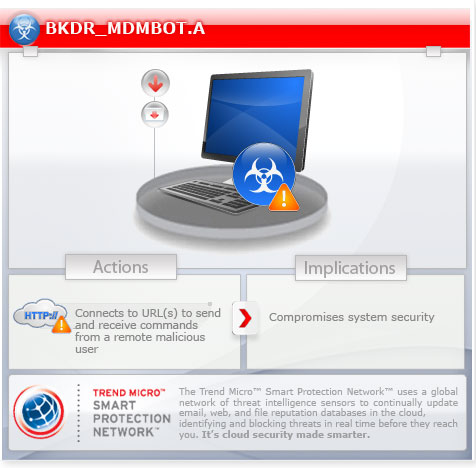BKDR_MDMBOT.A
Backdoor:Win32/Mdmbot.F (Microsoft), Backdoor.Win32.MmBot.b (Kaspersky), Win32/McRat.B trojan (Eset)
Windows 2000, Windows Server 2003, Windows XP (32-bit, 64-bit), Windows Vista (32-bit, 64-bit), Windows 7 (32-bit, 64-bit)


Threat Type: Backdoor
Destructiveness: No
Encrypted: Yes
In the wild: Yes
OVERVIEW
Dropped by other malware, Downloaded from the Internet
This backdoor is downloaded before through a previous zero-day Java exploit, now tagged as CVE-2013-1493. This malware is also used as a payload for a zero-day Internet Explorer bug.
To get a one-glance comprehensive view of the behavior of this Backdoor, refer to the Threat Diagram shown below.

This Backdoor arrives on a system as a file dropped by other malware or as a file downloaded unknowingly by users when visiting malicious sites.
It executes then deletes itself afterward.
It executes commands from a remote malicious user, effectively compromising the affected system.
TECHNICAL DETAILS
73,728 bytes
EXE
Yes
01 Mar 2013
Compromises system security, Collects system information
Arrival Details
This Backdoor arrives on a system as a file dropped by other malware or as a file downloaded unknowingly by users when visiting malicious sites.
Installation
This Backdoor drops the following component file(s):
- %User Profile%\AppMgmt.dll - also detected as BKDR_MDMBOT.A
(Note: %User Profile% is the current user's profile folder, which is usually C:\Documents and Settings\{user name} on Windows 2000, XP, and Server 2003, or C:\Users\{user name} on Windows Vista, 7, and 8.)
Its DLL component is injected to the following process(es):
- svchost.exe
It executes then deletes itself afterward.
Autostart Technique
This Backdoor modifies the following registry entries to ensure it automatic execution at every system startup:
HKEY_LOCAL_MACHINE\SYSTEM\CurrentControlSet\
Services\AppMgmt\Parameters
ServiceDll = "%User Profile%\AppMgmt.dll"
(Note: The default value data of the said registry entry is %System%\appmgmts.dll.)
Backdoor Routine
This Backdoor executes the following commands from a remote malicious user:
- Download and Load plugins - saved as %Temp%\{random}_p.ax or %Temp%\uid.ax
(Note: %Temp% is the Windows temporary folder, where it usually is C:\Windows\Temp on all Windows operating system versions.)
It connects to the following URL(s) to send and receive commands from a remote malicious user:
- {BLOCKED}.{BLOCKED}.55.187:80
- {BLOCKED}4.{BLOCKED}me.net:443
- {BLOCKED}.{BLOCKED}.143.244:443
- {BLOCKED}.{BLOCKED}.9.93:443
Information Theft
This Backdoor gathers the following data:
- Computer Name
- Admin rights
- OS Version
- Hostname
Other Details
This Backdoor connects to the following URL(s) to check for an Internet connection:
- update.microsoft.com
SOLUTION
9.300
9.761.00
01 Mar 2013
Step 1
Before doing any scans, Windows XP, Windows Vista, and Windows 7 users must disable System Restore to allow full scanning of their computers.
Step 2
Restart in Safe Mode
Step 3
Restore this modified registry value
Important: Editing the Windows Registry incorrectly can lead to irreversible system malfunction. Please do this step only if you know how or you can ask assistance from your system administrator. Else, check this Microsoft article first before modifying your computer's registry.
- In HKEY_LOCAL_MACHINE\SYSTEM\CurrentControlSet\Services\AppMgmt\Parameters
- From: ServiceDll = "%User Profile%\AppMgmt.dll"
To: ServiceDll = "%System%\appmgmts.dll"
- From: ServiceDll = "%User Profile%\AppMgmt.dll"
Step 4
Restart in normal mode and scan your computer with your Trend Micro product for files detected as BKDR_MDMBOT.A. If the detected files have already been cleaned, deleted, or quarantined by your Trend Micro product, no further step is required. You may opt to simply delete the quarantined files. Please check this Knowledge Base page for more information.
Did this description help? Tell us how we did.


